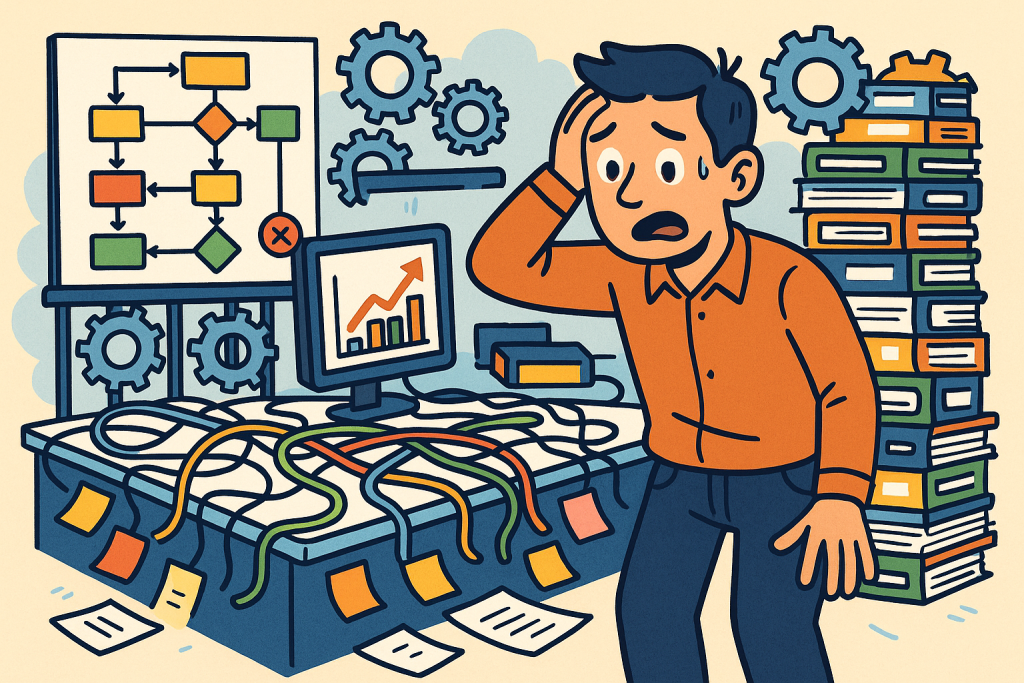Recognizing overbuilding your workflow is step one. When you add more steps than needed and burden your process, efficiency drops. This guide shows you how to recover from overbuilding your workflow to gain clarity and streamline effectively.

What Is Overbuilding Your Workflow?
Workflow overbuilding—akin to software over-engineering—is creating unneeded structure or complexity that doesn’t increase value. It’s when:
- You layer in tools, tasks, and automations that go unused.
- You enforce multi-step approvals for simple decisions.
- You design workflows for future scenarios that never arrive.
According to the Wikipedia definition of overengineering, this is exactly “designing a solution more complicated than necessary”. Parallels in the workflow world mean excessive effort without meaningful output.
The Hidden Costs of Overbuilding Your Workflow
It’s tempting to create detailed workflows thinking they’ll scale—but it’s often a trap:
- Slowed progress – Each extra step introduces friction.
- Team resistance – Clunky processes demotivate people.
- Unclear ownership – With more moving parts, accountability blurs.
- Burnout – Research links instability and excessive processes to staff exhaustion .
- Tool bloat – Gartner found nearly 40% of workplace tools are underutilized—overbuilt, unused, forgotten.
Signs You’ve Overbuilt Your Workflow
Recognize the problem with these red flags:
- Your onboarding takes too long.
- Decisions require endless approvals.
- Many tools go dormant after initial rollout.
- People work around processes instead of using them.
- Ticket backlogs grow while outputs stagnate.
- You spend most time maintaining workflows, not delivering value.
Steps to Recover from Overbuilding Your Workflow
1. Audit Workflow Complexity
- Document each step and tool.
- Ask: What value does this step provide today?
2. Prioritize Core Workflows
Decide which workflows are mission-critical. Everything else is optional or temporary.
3. Strip Back Unnecessary Steps
- Remove steps that serve only future-proofing.
- Combine approval steps where possible.
- Cut tools that add no daily value.
4. Adopt Incremental Automation
Rather than automating everything upfront:
- Start with a small, high-impact part.
- Measure efficiency gains and iterate.
- This aligns with studies on automation bots that emphasize simplicity, low noise, and controlled rollout.
5. Improve Transparency & Feedback
- Share streamlined processes openly.
- Solicit feedback monthly.
- Monitor process health with metrics like cycle time and internal satisfaction scores.
6. Build a Flow-Centric Culture
Encourage:
- Continuous process improvement.
- “Stop me if it slows you down” culture.
- Regular cleanup sprints instead of scaling complexity.
Avoiding Overbuilding in the Future
- Start with MVP workflows — build minimal documentation, tools, and approvals.
- Prototype small — test steps with a small team first.
- Re-evaluate quarterly — use audits to streamline.
- Stay cautious with tools — don’t adopt every new feature or platform.
- Prioritize business impact — discard anything that adds cost with little gain.
Real‑World Example: SaaS Team Refines Its Workflow
A SaaS startup initially deployed five tools for ticketing, backlog, CI/CD, approvals, and project planning. Six months later, much of it was unused. They:
- Removed two redundant tools.
- Consolidated approvals into a single triage board.
- Automated low-value commit checks only.
Within four weeks, deployment time dropped 30%, and developer satisfaction rose by 20%.
Summary Table: Before vs After Recovery
| Element | Before Overbuilding | After Recovery |
|---|---|---|
| Workflow Variety | Many overlapping workflows | 2–3 streamlined processes |
| Tool Count | 6+ tools, low usage | Essential tools only |
| Approval Steps | Multiple handoffs across teams | Single checkpoint |
| Automation Approach | Blanket automation | Targeted, measurable automation |
| Cultural Approach | “More is better” | Lean, feedback-based, value-driven |
Conclusion
Overbuilding your workflow is common—but reversible. By auditing for value, cutting unnecessary steps, automating strategically, and fostering feedback, you can shift your process from rigid to responsive. Your team will work smarter, not harder—with clarity and impact restored.
References
- Will, K. (2025, February 27). The productivity tool trap: Are they helping or just adding to the chaos?. LinkedIn. Retrieved from https://www.linkedin.com/pulse/productivity-tool-trap-helping-just-adding-chaos-will-kelly-ajpve linkedin.com
- Willtivity, J. (2025, April 25). Why Ooching Beats Overbuilding. Medium. Retrieved from https://medium.com
- Overengineering. (2025, June). Wikipedia. Retrieved from https://en.wikipedia.org






